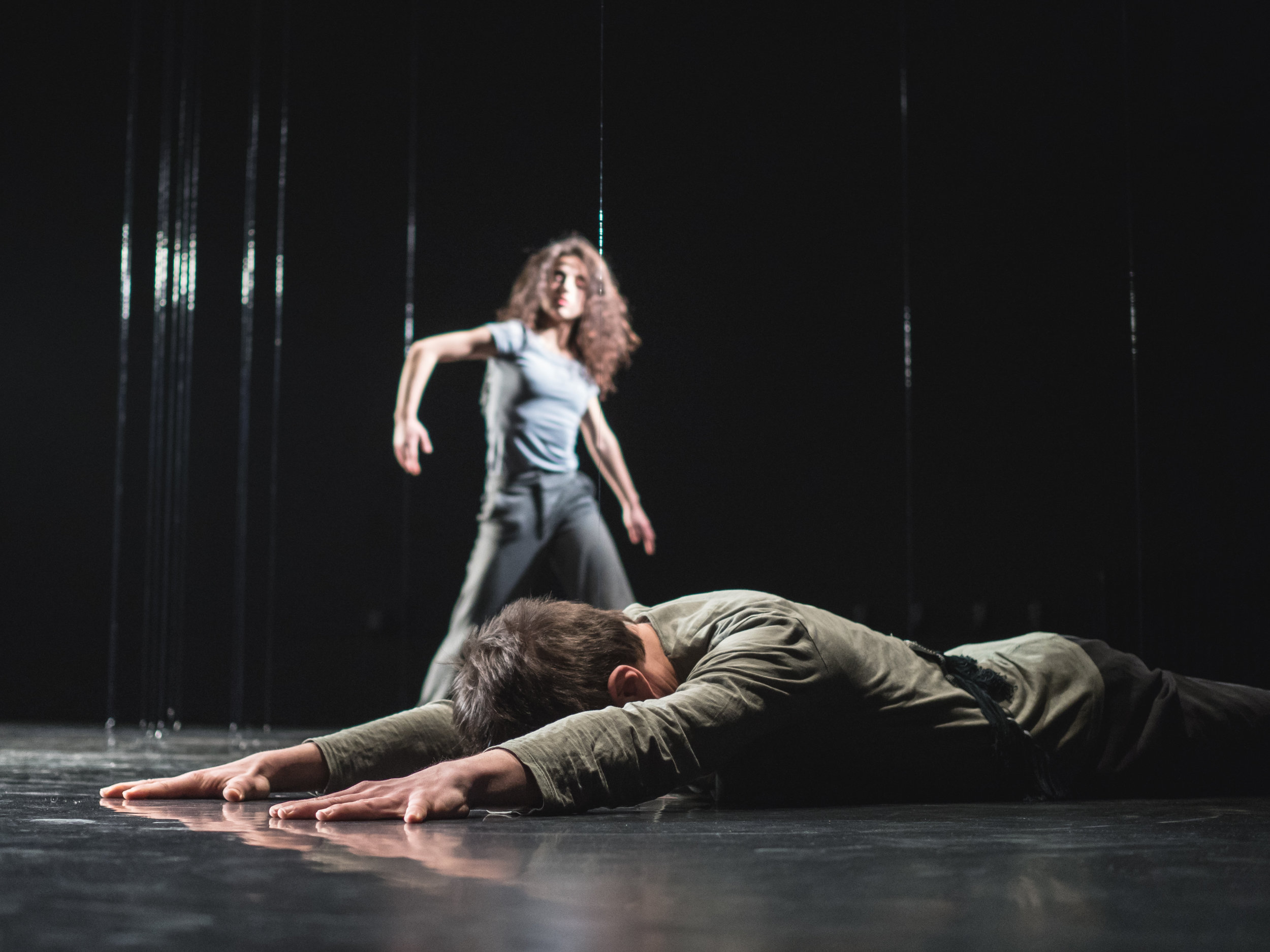Matevž Dobaj & Neus Barcons Roca
TJA. BLIZU ... / THERE. NEARBY …
plesni prvenec / a dance debut
Koncept, koreografija in izvedba / Concept, Choreography & Dance: Matevž Dobaj & Neus Barcons Roca
Dramaturgija / Dramaturgy: Andreja Kopač
Oblikovanje prostora in kostumov / Set & Costume Design: Ajda Tomazin
Oblikovanje luči in tehnične rešitve / Light Design & Technical Solutions: Janko Oven
Avtor glasbe in zvočna podoba / Music and Sound Design: Mario Marolt
Kreativni producent / Creative Producer: Katja Somrak
Produkcija / Produced by: Plesni Teater Ljubljana – Prvenec 2018 / Debut 2018
Program Plesnega Teatra Ljubljana sofinancirata Ministrstvo za kulturo RS in Mestna občina Ljubljana, Oddelek za kulturo / The programme of Plesni Teater Ljubljana is subsidized by the Ministry of Culture RS and Municipality of Ljubljana, Department for Culture
Foto / Photo: Drago Videmšek
O predstavi
Tja. Blizu … je nekaj, česar ne morem opisati … kako opredeliti, kaj se v resnici dogaja, če gre vedno za interpretacijo slišanega in zaznanega; za hkratno izdelavo smisla in pomena v enoti časa? Ko premik telesa v prostoru nakaže odstopanje oziroma prelamljanje v načinu gledanja skozi subtilno manipulacijo predhodnega dejanja, izrečene besede ali nakazanega giba, je vsakršen pomen, ki retrogradno nastane, običajno vrinjen in popačen; bodisi narativiziran bodisi abstrahiran.
Tja. Blizu … skuša ustvariti prostor, ki je za trenutek ločen od zunanjih dejavnikov, ki bi mu narekovali ritem in vsebino, v katerem je gib plesalca slišan in v katerem (se) gledalec hkrati lahko vidi. Kakor človeška izkušnja v zgodovini lastne interpretacije naglo izgublja dražljaj, tudi frekvencam zvoka in gibalnim strukturam pripisujemo pomen glede na lastne pretekle izkušnje. Če nam dražljaj uspe ločiti od izkušnje in ga zaznati neposredovano, lahko gledanje postane zaznava, pot in izziv hkrati.
Tja. Blizu … se hoče približati mesenosti stvari, pri katerih se pomenskost izpisuje skozi dihotomni ključ gledanja. Ob tem se postavlja vprašanje, kaj je njeno in kaj njegovo nasprotje in kaj sta drug drugemu v vertikalnem prostoru, v katerem niti določajo meje.
Tja … je doživljaj, empatija, kinetično izkustvo, skupnostna izkušnja … vseh nas.
Blizu … je diagram situacije; slikar ima pred sabo platno in platno je prazno, a kljub temu napolnjeno s klišeji.
Tja … je uničiti klišeje, ki so že tam.
Blizu … je načrt, kako to narediti.
Tja … je odprt za spremembe in dogodke, ki jih aktualizacija načrta potrebuje.
Blizu … je način dela; pojavi se kot sodelovanje med roko, očmi in načrtovanjem.
Tja … je neizogiben; prazen prostor ima vedno potencial, da postane kliše sam zase.
Blizu … in šele ko v ta prostor pride plesalec, začne kliše zares delovati, zato se je treba z njim nenehno ukvarjati.
Tja … čeprav je tudi vsaka interpretacija odrske izkušnje še vedno samo kliše.
Tja Blizu … je zato nenehno oddaljevanje od pomenov v želji po iskanju nečesa avtentičnega; namesto maščevanja intelekta skuša najti poti dotika, saj nikomur ni treba vedeti ničesar o tem plesu.
About the performance
There. Nearby … is something I cannot describe … how to define what is really going on, if it is always about the interpretation of what is heard and perceived; about the simultaneous production of sense and meaning in a unit of time? When a movement of the body in space indicates a deviation, a break in the perspective through the subtle manipulation of the preceding act, spoken word, or indicated motion, any meaning that emerges in retrospective is usually interposed and distorted; either narrativized or abstracted.
There. Nearby … is trying to create a space, which is momentarily separated from external factors, dictating the rhythm and content in which a movement of the dancer is heard and in which a viewer can see (himself). Just like human experience rapidly loses its stimulus in the history of its own interpretation, we ascribe meaning to sound frequencies and motion structures are ascribed meaning depending on our own past experience. If we succeed in separating the stimulus from the experience and perceiving it directly, viewing can become perception, journey and challenge at the same time.
There. Nearby … wants to come closer to the carnality of things where the meaning is being shown through the dichotomous key of viewing. This raises the question of what is hers and what is his opposite, and what they represent to each other in a vertical space in which boundaries are defined by threads.
There … is an experience, an empathy, a kinetic experience, a community experience … of all of us.
Nearby … is a diagram of the situation; a painter stands in front of a canvas, and the canvas is empty, yet still filled with clichés.
There … is to destroy the clichés which are already there.
Nearby … is the plan to do this.
There … is open for changes and events needed to realize the plan.
Nearby … is a mode of operation; it occurs as a cooperation among arms, eyes, and planning.
There … is inevitable; an empty space always has the potential to become a cliché by itself.
Nearby … and only when a dancer enters this space, the cliché begins to work, so it is necessary to deal with it all the time.
There … even though every interpretation of the stage experience is still nothing more than a cliché.
Nearby … is thus a constant departure from meanings in search of something authentic; instead of revenge of the intellect, it seeks to find the ways of touch, since nobody needs to know anything about this dance.

